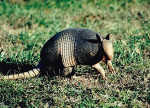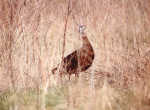- Missouri campgrounds resurgence (5/30/20)
- August a fantastic month for catfishing (8/11/18)
- Kayaking, canoeing good way to spend hot summer days (7/27/18)
- Hot weather means hot catfishing (7/7/18)
- Boat buyers have abundant options (6/16/18)
- Warm weather invites camping (6/9/18)
- Topwater fishing is a blast (6/2/18)
Winter makes for prime outdoor photography
Friday, December 27, 2013

An armadillo, as seen from a trail in the Stockton State Park, where they are almost common.
Now is the time for outdoor photography.
Since the leaves have fallen off of all of the trees, it's a good time to take a walk in the woods and hunt with a camera. Casually walking through the woods with a camera in hand rarely results in more than blurred images and an occasional "luck" shot, though.
There is a lot more to this kind of photography than most hobbyists realize. All good wildlife photographers know the importance of the three Ps: Preparedness, Patience and Practice.

A hen wild turkey, as seen from a trail at Pomme de Terre Lake.
Anyone with outdoor experience already appreciates the importance of being prepared. The 35 millimeter is the most popular format and medium telephoto lenses are the most common. The digital cameras of today have made photography a lot easier for everyone.
Both the area and wildlife are important.
If whitetail deer are going to be photographed, familiarizing yourself with their habits will save time and a lot of frustration. Most other wildlife are the same way.
Information sources are as close as your local library or local hunters. Books provide general information and the hunters can tell you about local patterns most wildlife tend to follow and where they are most plentiful.
The best way to learn about wildlife is by spending time in the woods. It won't take long to observe that deer, for example, maintain the same habits after the hunting seasons have ended.
Rod Hendricks, project manager of the Stockton Dam, said, "An excellent place for wildlife photography is in any of the many parks surrounding the big impoundments, like Table Rock, Truman, Pomme de Terre and Stockton. There are trails around or near the lakes where you might see all kinds of wildlife to photograph.
"At Pomme de Terre, there is a nice trail below the dam. Truman has a great trail system from the dam to the city of Warsaw.
"You never know what you might see along these trails. The state parks also have some good trails that offer chances to see wildlife to photograph.
"Another plus of being along a trail this time of year is that you don't have to put up with ticks, snakes or spider webs across the trail. It's a good time to grab your camera and go for a walk in the woods."
Most wildlife cover shots in outdoor magazines didn't come from shooting out of the window of a vehicle. These dedicated professionals often sat in a blind for hours, or sometimes, days before they snapped the shutter. They know that most wild animals have senses that tell them when humans are around.
It is often said that photography is the art of painting with light. This is especially true in wildlife photography.
Once you know where you are likely to find animals, it is important to visit the locations at various times of the day to study light. A good photo blind or stand will put you close to the animals. It also takes advantage of utilizing the best light.
Dressing properly is equally important. In most types of wildlife photography, clothing needs to be comfortable, convenient, camouflaged and quiet.
Being upwind from a 12-point buck is no time to be shooing a bug off your face. It is a good idea to include insect repellent as part of your outdoor gear, even at this time of the year.
Getting that great shot, for even the best of wildlife photographers, is not an easy task.
It might be difficult to get wildlife shots, but when you do, it can be very rewarding.
Several years ago, Robert Smith, a Kansas City amateur photographer, spent hours near Table Rock Lake waiting to get a shot of a big buck he had seen. Finally, one cold morning, he was able to get a great shot of the big buck with steam coming from his mouth.
He now can relive that moment by looking at the large photo hanging over his fireplace.
"It was well worth the wait," he said.

